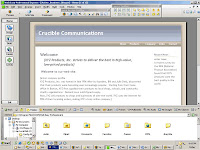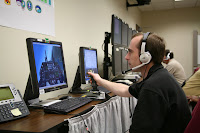AUDIO EDITING SOFTWARE
BITMAP IMAGE
Bitmap images are raster images that are made up of pixels in rows and columns. Pixels are picture elements which are tiny blocks of individual colour that come together to form images on the computer screen. It carries the extension .bmp and use bits of 1 and 0 to store data. theb In a bitmap image, each pixel is assigned at least one bit to indicate whether the pixel should reflect background color, the foreground color, or some other color.
DESKTOP PUBLISHING PROGRAM
Desktop publishing program is a tool for graphic designers and non-designers to create visual communications for professional or desktop printing as well as for online or on-screen electronic publishing. It combines a personal computer and WYSIWYG (what you see is what you get) page layout software to create publication documents on a computer for either large scale publishing or small scale local multifunction peripheral output and distribution. The same software is often used to create graphics for point of sale displays, promotional items, etc.
HTML EDITORS
HTML editors are authoring tool that is essentially a text editor, specialized for writing HTML codes as you create a HTML file. Some editors will provide a word processing GUI enabling users to create HTML documents without knowing any HTML code. For example, many HTML editors work not only with HTML, but also with related technologies such as CSS, XML and JavaScript or ECMAScript.
IMAGE EDITORS
Image editors are a type of software that allows images to be edited and also converted to different graphics formats, whether they be digital photographs, traditional analog photographs, or illustrations. Common functions are manually cropping and resizing the image and using "filters" to adjust brightness, contrast and colours. Many image editors are also used to render or create computer art from scratch.
MULTIMEDIA
Multimedia is the integration of multiple forms of media which includes text, graphics, audio and video. For example, a presentation involving audio and video clips would be considered a "multimedia presentation." CDs and DVDs are often considered to be "multimedia formats" since they can store a lot of data and most forms of multimedia require a lot of disk space. Multimedia is usually recorded and played, but it can also be part of a live performance.
VECTOR IMAGE
Vector image is an image created using mathematical statements that define geometric shapes. Vector images are comprised of paths, which are defined by a start and end point, along with other points, curves, and angles along the way. Because vector-based images are not made up of a specific number of dots, you can move, resize, and change the color of vector graphics without losing any quality. Unlike bitmaps, vector graphics are not dependent on resolution. You can scale a vector graphic to any size and it won’t lose detail or clarity.


























